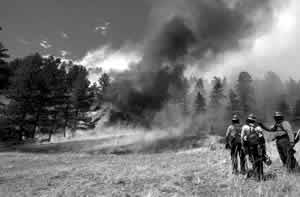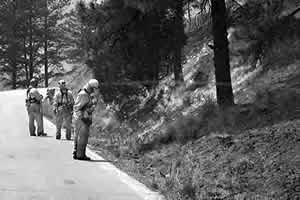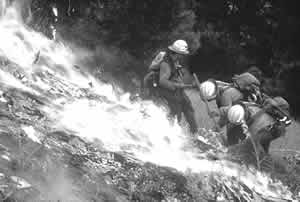The Red Card:
The Driver’s License of Firefighting
The firefighting “red card” is required to verify
and document wildland firefighter qualifications. The following
was adapted from the information provided by the Kansas Forest
Service to provide guidance in dealing with the Incident
Qualification System (IQS) and the associated “Red
Card.”
| |
 |
| |
Southern part of the Hayman fire. The Tatanka Hot Shots
burns out around structures. Photo by Karen Wattenmaker. |
| |
|
1. What is a Red Card?
The red card itself is no more than a printout of the current
wildland fire qualifications of an individual. It’s
part of the fire qualifications management system used
by most state and federal wildland fire management agencies.
All firefighters assigned to a fire being managed by a
federal agency (U.S. Forest Service, Bureau of Land Management,
National Park Service, Bureau of Indian Affairs or U.S.
Fish & Wildlife) and many state agencies are required
to have a red card. In a sense, it’s similar to your
drivers license. It shows that the holder of the card has
completed all the course work and training required to
hold a particular position.
2. How do I obtain a Red Card?
The steps necessary to obtain a red card and progress upward
through the qualification system to higher rank and responsibility
is outlined in the Wildland and Prescribed Fire Qualifications
System Guide, Publications Management System number PMS
310-1. A copy of it is available on the U.S. Forest Service
Fire and Aviation Management web page (file located at
http://www.nwcg.gov/pms/docs/310-1new.pdf).
 |
|
Engine Crew monitors a fire burning
along the road.
Photo by Tim Sutten.
|
|
| |
|
3. What are the steps to obtain the minimum qualification?
There is a base or introductory level that every firefighter
is required to achieve before they can progress upward in
the system. It starts by taking two classes. (All the courses
are categorized by a 4-5 digit identifier, S-190 for example
- ‘S’ is used for skills courses, ‘I’ for
incident command, ‘D’ for dispatch, ‘RX’ for
prescribed fire). S-130, Firefighter Training and S-190,
Introduction to Wildland Fire Behavior are two separate courses
usually offered simultaneously because they represent the
entry level. Combined, these usually take about 4 days of
instruction to complete. (They are also sometimes combined
with I-100, Introduction to ICS.) The next step is to complete
another short course, Standards for Survival. It’s
usually about 4 hours long and is taken every year as a refresher.
It re-emphasizes the importance of safety on the fireline
and includes a practice fire shelter deployment. The final
step in obtaining a red card is to pass the fitness test.
Most wildland fire agencies are using a test called the “pack” test.
Depending on your predicted fireline assignment, there are
three levels: light, moderate and arduous. Primary firefighters
are required to pass the arduous level, a three-mile hike
with a 45-pound pack in less than 45 minutes.
| |
 |
| |
A crew fights one of last season’s fires in Colorado. |
| |
|
4. Once I have the Red Card, what do I do to move up in the
system?
Those are the three basic steps in getting into the red card
system - complete the S-130/190, complete Standards for Survival
and practice shelter deployment and successfully complete
the pack test. That will get you a red card and you will
be considered a Type II firefighter (FFT2). A firefighter
at this level will probably be a crew member (Hot Shot or
hand crew, engine, helicopter, etc) with limited responsibilities
other than fire suppression (line construction, engine operation,
etc). To move beyond this level (the next level is a squad
boss, FFT1) is a combination of courses and on the job training.
Courses must be completed first and then a “taskbook” will
be issued to the firefighter. It contains a listing of various
tasks and duties that must be performed in a variety of ways
under the supervision of a firefighter at a higher level.
Upon completion of each task and duty, your supervisor initials
your task book to signify that you have done the job successfully.
When the entire book is complete, the firefighter will be
considered qualified and certified at that level. 5. Where can students can obtain this training?
Here are just a few of potential sites for wildland fire
training in Colorado. Many agencies offer their own fire
training programs, check with your emergency management
department for details.
Great Plains Wildfire College http://www.cowildfireacademy.com/college.html
Colorado Wildfire Academy
http://www.cowildfireacademy.com/adescription.html
Colorado Northwest Community College
http://www.cncc.edu/alumni/newsletter/04_firefighting.htm
Rocky Mountain Wildland Fire Training
http://www.nationalfiretraining.net/rm/rmcg.htm
Other Wildland Fire Training Links
http://www.fs.fed.us/fire/training/fire_training.html
| The Wildland and Prescribed Fire Qualifications System
Guide was developed to provide guidance to agencies and
organizations in establishing minimum interagency training,
skills, knowledge, experience and physical fitness standards
for wildland fire positions. The guide can be downloaded
at http://www.nwcg.gov/pms/docs/310-1new.pdf. |
Fires are not ‘put out’
Wildfires
are fought by a diverse group of firefighters and support
personnel from more than 20 local, state and
federal agencies. The goal is to mitigate unwanted fire and
provide public safety.
Wildfires are not “put out” in the sense that
a house fire is extinguished. Firefighters surround wildfires
within defensible boundaries. Fire line (constructed by hand,
by bulldozer, and by retardant drops, or extended to existing
trails or roads) and natural features (streams, lakes, rock
outcrops, ridgelines, and already burned areas) are connected
to surround the fire. Once the main fire is surrounded, firefighters
mop up remaining hotspots and the fire line to achieve control
over the fire.
If you are involved in a firefighting effort you should
be familiar with wildfire terminology.
An extensive list of
Wildland Fire Terminology is provided by the Coalition
for the Upper South Platte (CUSP) Hayman
Recovery Assistance at: http://www.fs.fed.us/r2/psicc/hayres/terminology.htm.
|

